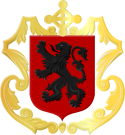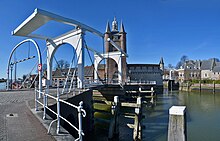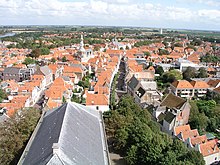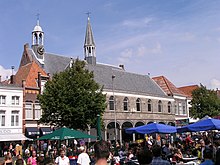Zierikzee
 flag |
 coat of arms |
| province |
|
| local community |
|
|
Area - land - water |
23.44 km 2 22.54 km 2 0.9 km 2 |
| Residents | 11,150 (Jan. 1, 2017) |
| Coordinates | 51 ° 39 ′ N , 3 ° 55 ′ E |
| Important traffic route |
|
| prefix | 0111 |
| Postcodes | 4207, 4301 |
| Website | Homepage of Zierikzee |
| Location of Zierikzee in the municipality of Schouwen-Duiveland | |

Zierikzee (old spelling: Zierczee , Ziericzee ; Zeeland Zurrikzeê ) is a city in the southeast of the island of Schouwen-Duiveland in the Dutch province of Zeeland . Zierikzee is the administrative seat of the eponymous municipality Schouwen-Duiveland, which includes all localities on the island of the same name.
The city stretches over around 2,300 hectares and had 11,150 inhabitants in January 2017. Around 55 percent of the working population work in the service sector. Through the Zeelandbrug ( German Seelandbrücke ), Zierikzee is connected to Noord-Beveland and thus to the extreme south of the Netherlands and towards Antwerp and Ghent .
history
The name
The fact that the place owes its name to a Hungarian explorer named Ziringus von Zirik can be referred to in the realm of legends. More probable is a Frisian settler named Zierik, who grew up to be a local ruler and was called "Zieriks Ee" after the bay on the river Ee. The current place name would be a genitive attribution and accordingly read »Zierikz'ee« separately and not, as usual, to separate after Zierik'zee, as if there were a corresponding lake on site.
Early history
Zierikzee is said to have been founded around 849. The first archaeological evidence of settlement can be found from the 11th century. As is likely to apply to the whole of Schouwen, the times of rising water levels in the 9th and 10th centuries were waited for before the island was gradually viewed as a settlement area again.
A document from the Sint Baaf Abbey in Ghent recorded a property on Schouwen called "Creka" in 976, which could mean (the area of today's) Zierikzee. This is to be assumed, since relations with the abbey did not break off later either. The city's patron saint, Sint Lieven , is probably a fiction that originated in Sint Baaf.
The first reliable mention of Zierikzees dates from the time after the great storm surge of 1134 and calls the place 1156 "Siricasha". Shortly afterwards, a church designed in the Romanesque style should have been built. The castle opposite the church was of older origin and was probably founded by the Flemish Count Boudewijn V , but passed into the hands of the Dutch count as early as 1048.
The folkloric traditions want Zierikzee as the home of Kirke see Greek mythology, such as also * Ulyssingen ( Vlissingen ) by Ulysses ( Odysseus said to have been named as the founder).
From the 13th century onwards
The clashes between Flemings and Dutch over Zeeland now determined large parts of the strategically located Zierikzee. A first siege of the place is reported for 1205, which must have been fortified. In 1217 (or between 1219 and 1222) Count Willem II of Holland then granted the town its city rights, which were confirmed on March 11, 1248. In accordance with the new legal situation, the city now experienced a certain boom; from here salt and herring, but also cloth and red dye, were traded. A port canal to the Oosterschelde was created when the Gouwe, which separated Schouwen from Duiveland to the east, silted up.
In the 13th century there was not only a gasthuis (German hospital ) and a vleeshal , but also a beguinage (1256), a monastery of the preachers (around 1275) and a Minorite monastery (1260) in the city. This Eksterbroeders monastery quickly went under again. The increase in importance corresponded to an increasing involvement in the war between the Dutch and the Flemings. After Willem, the son of Jan II , had already found refuge in the city in 1303 , he had to cede large areas to the Flemish under Gwijde van Namen (from which Zierikzee was explicitly excluded). Another Dutch attempt to maintain supremacy in Zeeland ended in complete defeat, in which Gewijde van Avesnes , the bishop of Utrecht, was captured and Willem had to seek refuge again in Zierikzee. The city was initially unmolested by the armed forces marching on Utrecht (meanwhile Witte van Hamsteede (1280 / 82-1321), the illegitimate son Floris V tried to unite the Dutch cities against the Flemings), but then came after the Most of the major strategic points on Schouwen-Duiveland Flemish posts had been erected, yet again in sight of the enemy.
In 1304, a Flemish armed force then raised up on land and sea off Zierikzee, with around 120,000 soldiers must have been of impressive size. The city was approached with all the art of war and siege and all the machinery available for this, repeatedly dared to make smaller failures, but only survived through the tough resistance, especially from women, who once tore down some streets of the city so that the men could Throwing stones at the besiegers, then extinguishing them and starving them again, thus prolonging the siege, until finally a fleet of Dutch and French warships arrived under the command of the Monegasque Admiral Raniero Grimaldi . The fleet was inferior to the Flemish in numbers and combat strength, but the luck of war and the tides finally brought victory to the Dutch and their allies in the battle that broke out on August 10, 1304. Willem, who was on board one of the ships, moved again, but now not on the run, but as Willem III. , Count of Holland, Zeeland and Hainaut (Henegouwen), entered the city.
In 1575, at the beginning of the Eighty Years War (1568–1648), the Spanish general Don Cristóbal de Mondragón appeared in front of the city and conquered it after a nine-month siege, but then withdrew again soon.
Buildings
Zierikzee's best-known building is the monumental church tower of the former St. Lievens Church , which can be seen from afar and is known as the “Monstertoren” (= cathedral tower). It was started in 1454. Other sacred buildings are the Lutherse Kerk from 1713, the Gasthuiskerk (hospital church) from the 15th century. Century and as a replacement for the church that was abandoned in 1832, the Nieuwe Kerk, built in neoclassical style in 1835–1848 .
Other noteworthy buildings are the Stadhuis (town hall) from the 16th century with alterations from the 18th century and the three gates of the old city fortifications: Nobelpoort, Noordhavenpoort and Zuidhavenpoort.
Town twinning
Zierikzee's twin cities are Hatfield in the United Kingdom and Saint-Hilaire-du-Harcouët in France .
sons and daughters of the town
- Karel Slabbaert (1619-1654), painter and draftsman, in Middelburg active
- Johannes Cornelis de Jonge (1793-1853), historian
- Pieter Caland (1826–1902), engineer
- Abraham J. Muste (1885–1967), socialist peace and trade union activist, Reformed pastor (emigrated to the USA as a child)
- Adrie Koster (* 1954), former soccer player and today's coach
- Peter van Vossen (* 1968), former soccer player
Zeelandbrug and other traffic routes
The Zeelandbrug, opened in 1965 between Schouwen-Duiveland and the small island of Noord-Beveland, is part of Provinciale Weg 256 .
literature
- Gids voor Zierikzee en de eilanden Schouwen en Duiveland ; Haamstede 1881
- J. de Kanter, Chronijk van Zierikzee ; Zierikzee 1795
- Jan Pot, Het van Zierikzee ; Diss., Leiden 1925
- H. Uil, Zierikzeese straatnamen ; Alphen adR 1986
- ders., Zierikzee. Monumentenstad aan de Schelde ; Goes 1995 ( ISBN 90-72138-45-7 )
- ders., Zierikzee. Stad met vele faces ; Goes 1996 ( ISBN 90-72138-56-2 )
- JJ Westendorp Boerma u. CA van Swigchem, Zierikzee vroeger en nu ; Bussum 1972
- Stadsontdekkingstocht Zeeland. In the voetspoor van de heersers uit een roemrijk maritiem verleden ; (= Zeeland Maritiem), ed. v. Bureau voor Toerisme Zeeland
- Peter Wijnen, Een rondje Zierikzee ; Zierikzee 1992
Web links
- City website (Dutch)
- Zierikzee: Website of the tourist board VVV Zeeland (German, Dutch, English)
- Illustration by Frans Hogenberg from 1588: Ziericzee is a place in Zeeland old, the Kunig is documented by great violence, ... ( digitalized )
Individual evidence
- ↑ a b Kerncijfers wijken en buurten 2017 Centraal Bureau voor de Statistiek , accessed on April 7, 2018 (Dutch)
- ^ Jupiter, Nostradamus, Edgar Cayce, and the Return of the Mongols. In: cassiopaea.org. Retrieved July 4, 2018 .
- ↑ Zierikzee. In: plaatsengids.nl/. 2018, accessed July 4, 2018 (Dutch).
- ↑ De afloop van de Guldensporenslag. In: dekroniekenvandewesthoek.be. Retrieved July 4, 2018 (Dutch).
- ↑ De slag om Zierikzee in 1304. In: isgeschiedenis.nl/. Retrieved July 4, 2018 (Dutch).
- ↑ H. Uil: De Tachtigjarige Oorlog. In: zierikzee-monumentenstad.nl. Retrieved July 4, 2018 (Dutch).











